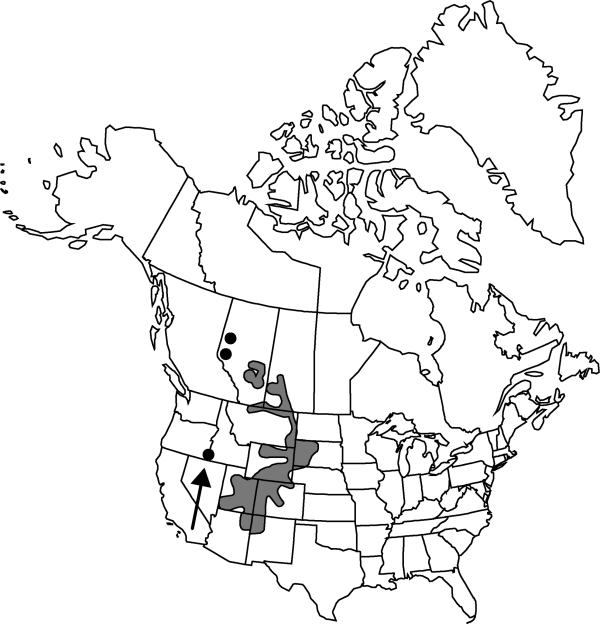Difference between revisions of "Atriplex powellii"
Proc. Amer. Acad. Arts 9: 114. 1874.
FNA>Volume Importer |
RevisionBot (talk | contribs) m (Bot: Adding category Revised Since Print) |
||
| (3 intermediate revisions by 2 users not shown) | |||
| Line 8: | Line 8: | ||
}} | }} | ||
|common_names=Powell’s orach | |common_names=Powell’s orach | ||
| + | |special_status={{Treatment/ID/Special_status | ||
| + | |code=E | ||
| + | |label=Endemic | ||
| + | }} | ||
|basionyms= | |basionyms= | ||
|synonyms={{Treatment/ID/Synonym | |synonyms={{Treatment/ID/Synonym | ||
| Line 24: | Line 28: | ||
-->{{Treatment/Body | -->{{Treatment/Body | ||
| − | |distribution= | + | |distribution=Alta.;Sask.;Ariz.;Colo.;Idaho;Mont.;N.Mex.;Nebr.;Oreg.;S.Dak.;Utah;Wyo. |
|discussion=<p>Varieties 2 (2 in the flora).</p> | |discussion=<p>Varieties 2 (2 in the flora).</p> | ||
|tables= | |tables= | ||
| Line 54: | Line 58: | ||
|basionyms= | |basionyms= | ||
|family=Chenopodiaceae | |family=Chenopodiaceae | ||
| − | |distribution= | + | |distribution=Alta.;Sask.;Ariz.;Colo.;Idaho;Mont.;N.Mex.;Nebr.;Oreg.;S.Dak.;Utah;Wyo. |
|reference=None | |reference=None | ||
|publication title=Proc. Amer. Acad. Arts | |publication title=Proc. Amer. Acad. Arts | ||
|publication year=1874 | |publication year=1874 | ||
| − | |special status= | + | |special status=Endemic |
| − | |source xml=https:// | + | |source xml=https://bitbucket.org/aafc-mbb/fna-data-curation/src/2e0870ddd59836b60bcf96646a41e87ea5a5943a/coarse_grained_fna_xml/V4/V4_677.xml |
|genus=Atriplex | |genus=Atriplex | ||
|subgenus=Atriplex subg. Obione | |subgenus=Atriplex subg. Obione | ||
| Line 67: | Line 71: | ||
}}<!-- | }}<!-- | ||
| − | -->[[Category:Treatment]][[Category:Atriplex subsect. Argenteae]] | + | --> |
| + | |||
| + | [[Category:Treatment]] | ||
| + | [[Category:Atriplex subsect. Argenteae]] | ||
| + | [[Category:Revised Since Print]] | ||
Latest revision as of 17:03, 6 November 2020
Herbs, dioecious or sometimes sparingly monoecious. Stems slender to stout, mainly 1–5(–7) dm, branching almost throughout; herbage pubescent with scurfy and arachnoid hairs. Leaves alternate, proximalmost on petioles (3–)5–30 mm, becoming subsessile or short petiolate distally; blade 3-veined, ovate to rhombic or orbiculate to elliptic, 0.4–5 × 0.2–3 cm, base rounded to cuneate, margin entire, apex acute to obtuse. Staminate flowers with calyx 4–5-lobed. Fruiting bracteoles sessile, ovate to oblong or broadly cuneate or pan-duriform, 1.5–5.5 × 1.5–5 mm, thick, united to apex, apex truncate to cuspidate or tridentate, surfaces with thickened processes or rarely smooth. Seeds greenish, yellowish, or brown, 0.9–2 mm; radicle superior. 2n = 18.
Distribution

Alta., Sask., Ariz., Colo., Idaho, Mont., N.Mex., Nebr., Oreg., S.Dak., Utah, Wyo.
Discussion
Varieties 2 (2 in the flora).
Selected References
None.
Key
| 1 | Leaves mostly conspicuously 3-veined, proximalmost with petioles 0.5-2.5(-3.5) cm, distalmost bracteate leaves typically short petiolate; fruiting bracteoles easily discerned at bract bases; plants mostly dioecious; from Alberta and Saskatchewan s to Utah and New Mexico | Atriplex powellii var. powellii |
| 1 | Leaves inconspicuously, if at all, 3-veined, proximalmost with petioles 0.5-1.5(-2) cm, distalmost bracteate leaves typically sessile; fruiting bracteoles apparent only by removing the subtending bract; plants evidently monoecious; local distribution in se Utah. | Atriplex powellii var. minuticarpa |